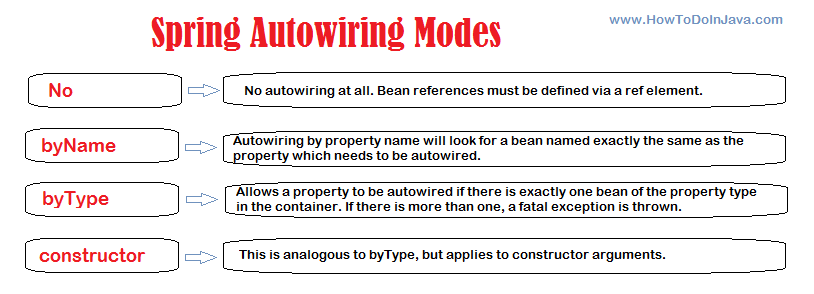In Spring Framework, autowiring is the feature that injects dependencies into a bean automatically. One of the autowiring modes is “byConstructor“ which injects dependencies into a bean by utilizing its constructor.
Dependency injection using constructors is the recommended approach in the Spring framework. Note that autowiring by type is the default mode.
The recommended way is to create a constructor only for mandatory dependencies and use setter injection for optional dependencies.
1. What is Autowiring By Constructor?
Autowiring by constructor involves automatically injecting dependencies by matching them with the constructor parameters of a bean. Using the @Autowired annotation is optional and it seems to have no affect at all.
@Component
public class ShapeService {
public ShapeService(Shape shape) {
this.shape = shape;
}
private Shape shape;
//use shape
}2. Understanding Autowiring By Constructor with Example
Suppose we have a ShapeService class that performs some action on the Shape object whatever is injected into it.
import org.springframework.stereotype.Component;
@Component
public class ShapeService {
public ShapeService(Shape shape) {
this.shape = shape;
}
private Shape shape;
public void drawShape() {
if (shape != null) {
shape.draw();
} else {
System.out.println("No shape set.");
}
}
}The Shape is an abstract type that can have multiple implementations.
public abstract class Shape {
abstract void draw();
}Now imagine we created two such implementations of Shape as follows:
public class Square extends Shape {
@Override
void draw() {
System.out.println("Drawing the Square");
}
}
public class Circle extends Shape {
@Override
void draw() {
System.out.println("Drawing the Circle");
}
}To create the beans from the above classes, we create the BeanConfig class. Here we can define all the beans that must be present in the application context.
@Configuration
@ComponentScan
public class BeanConfig {
/* @Bean
Square square() {
return new Square();
}*/
@Bean
Circle circle() {
return new Circle();
}
}To run the program, we use the AnnotationConfigApplicationContext to load the beans and access any of the bean methods.
public class AutowiredByTypeExample {
public static void main(String[] args) {
AnnotationConfigApplicationContext context = new AnnotationConfigApplicationContext(BeanConfig.class);
ShapeService shapeService = context.getBean(ShapeService.class);
shapeService.drawShape();
}
}2.1. Multiple Beans of the Same Type causes NoUniqueBeanDefinitionException
When we run the above application with the following bean configuration then Spring finds multiple candidates (Square and Circle) to inject into ShapeService so it throws an exception.
@Configuration
@ComponentScan
public class BeanConfig {
@Bean
Square square() {
return new Square();
}
@Bean
Circle circle() {
return new Circle();
}
}When we run the program, we get the exception:
Caused by: org.springframework.beans.factory.NoUniqueBeanDefinitionException: No qualifying bean of type
'com.howtodoinjava.core.autowire.constructor.Shape' available: expected single matching bean but found 2:
square,circle2.2. Only a Single Matching Bean works Perfectly
Suppose we remove the Square (or Circle) bean. Since there is only one bean of type Shape in the context (either Circle or Square), Spring will successfully autowire it, and you will see the appropriate draw message.
@Configuration
@ComponentScan
public class BeanConfig {
@Bean
Square square() {
return new Square();
}
}Run the program and verify the output:
Drawing the Square2.3 No Matching Bean causes NoSuchBeanDefinitionException
Comment out both Circle and Square beans in the configuration. Now Spring will not find any matching bean in the context. Spring will throw an exception saying the “expected at least 1 bean which qualifies as autowire candidate“.
@Configuration
public class BeanConfig {
//comment out both beans
}Run the program and verify the output:
Caused by: org.springframework.beans.factory.NoSuchBeanDefinitionException: No qualifying bean of type
'com.howtodoinjava.core.autowire.constructor.Shape' available: expected at least 1 bean which qualifies as autowire
candidate. Dependency annotations: {}3. Conclusion
Autowiring by constructor in Spring is a concise and effective way to inject dependencies into beans. It is the recommended approach as well.
However, be cautious of conflicts when multiple beans of the same type exist.
Happy Learning !!


Comments